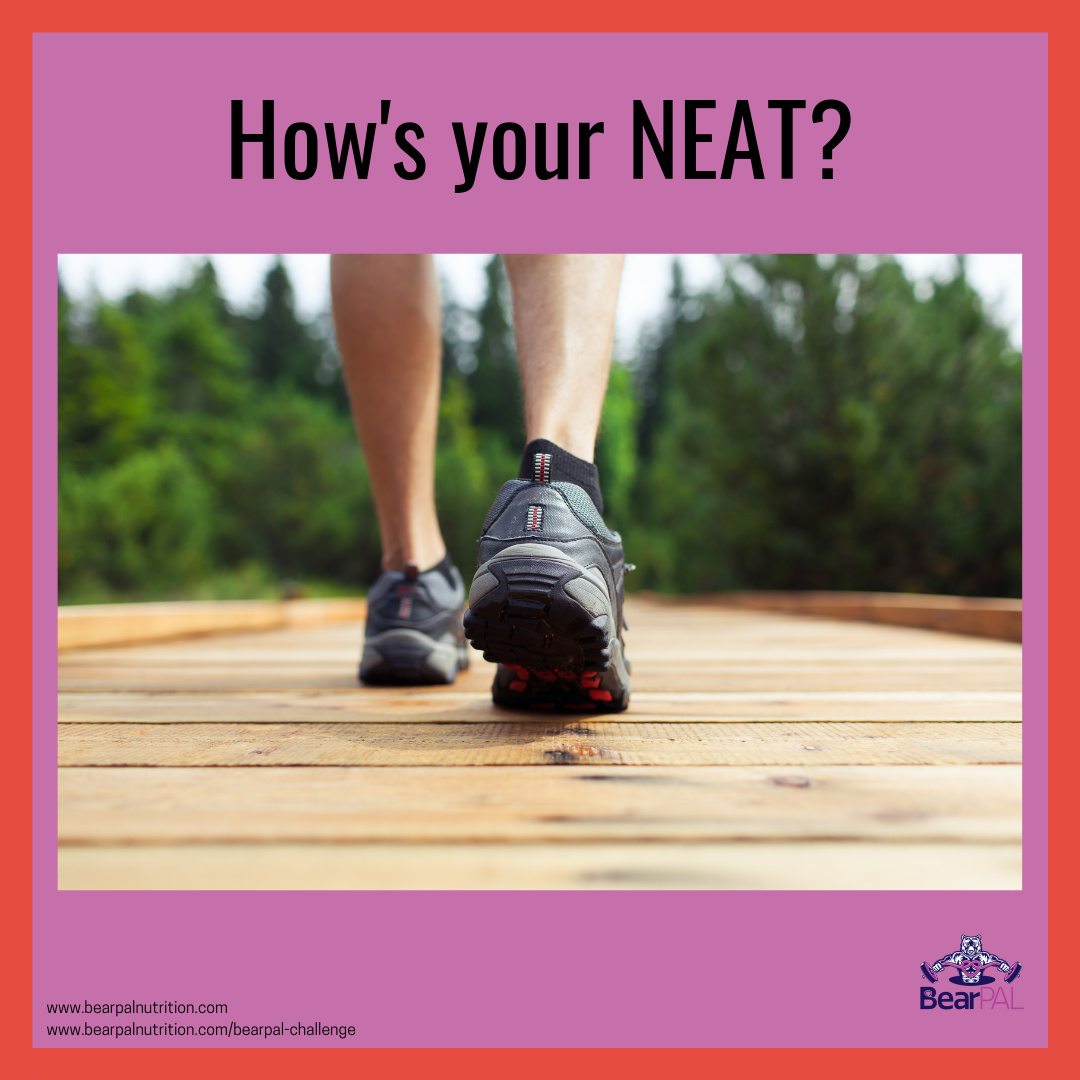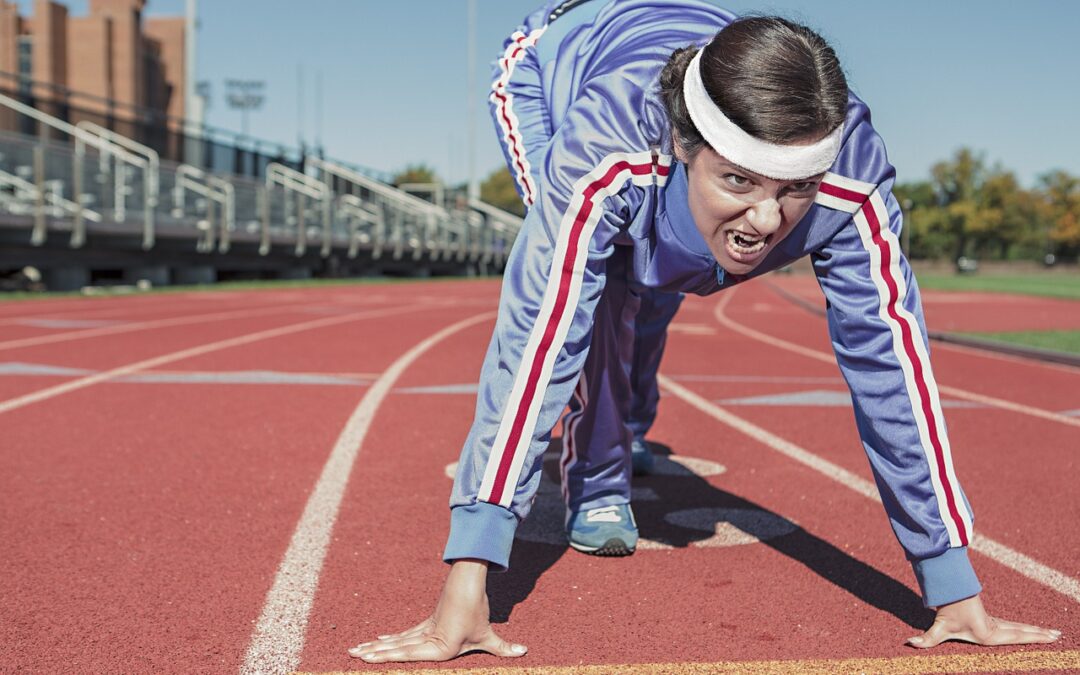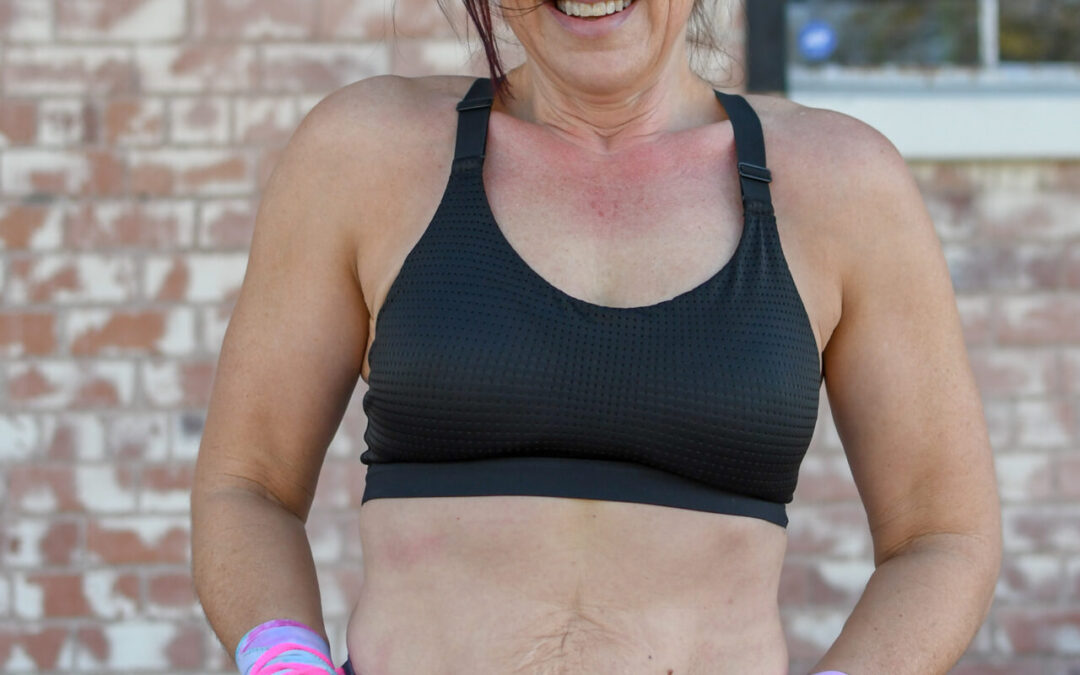Energy balance decides whether you gain weight or lose weight. Simple, right? Yes and no. Your body is a system that abides by the laws of thermodynamics. If you have calories in greater than energy calories out – you will store fat. If intake equals out – you maintain. When out is greater than in – you lose. The equation is different for every person based on numerous factors, but let’s talk about one of the energy out components – Nonexercise Activity Thermogenesis or NEAT.
Your total daily energy expenditure (TDEE) is made up of several components. First, your basal metabolic rate (BMR), which is the amount of energy you need just to be, just to keep you breathing and lying still without any movement or digestion. For most people, this stays relatively stable for their body mass. Second, is the thermic effect of food or TEF. TEF is the number of calories needed to process, digest and absorb your food. Someone with a bigger body mass will have a greater BMR. Your BMR accounts for around 60% of your daily energy use and your TEF around 15% [1]. Both your BMR and TEF happen without your conscious knowledge or control. So, what makes up the additional 25% of TDEE?
A little history about NEAT
The remaining components of the TDEE are the ones we have the most control of – activity. It includes exercise activity (EA) and the nonexercise component – NEAT. First, a bit about EA. Exercise activity is purposeful exercise to gain or maintain physical fitness. EA is a modern development. We did not go pump iron or climb up and down a hill for fitness even as recently as a century or so ago. We didn’t need to because we were hunting for food, tending fields, or laboring otherwise. For most of the world, the daily EA is zero. And, for those of us who do exercise on the regular, it is less than 100 calories per day and 2 hours per week [1]. Why do we exercise now? We lost that part of our occupational non-exercise activity when we became a desk-oriented culture with modern conveniences. We lost a source of our NEAT. Are we becoming fatter because of the loss?
Researchers theorize that NEAT can vary up to 2000 calories per day based on our occupation and leisure activity choices [2]. Therefore, NEAT is potentially way more impactful than 100 calories per day of exercise activity on your ability to lose or maintain fat loss. But, what makes up NEAT? NEAT includes both purposeful and spontaneous movement such as walking, fidgeting, standing, dancing, yard and housework, etc. There are three main categories of NEAT including body posture (sitting vs. standing), ambulation (walking), and all others like fidgeting [4]. Fidgeting alone can be 20-40% of total NEAT in some individuals [3].
NEAT is different for everyone
Our individual NEAT is dependent on factors such as biology, genetics, environment, occupation, culture, and leisure pursuits amongst others. Researchers are still investigating how much of our genetics determine whether we naturally have a high NEAT. Seasons, age, temperature (ambient and body), and gender may affect NEAT output as well. NEAT can vary between 15% and 50% of activity calories in sedentary vs. highly active people [3]! When your buddy brags about how much they can eat without any exercise and stay naturally slim, watch them to see if they are a high NEATer. Unlike EA which is all purposeful, NEAT is partially voluntary and partially spontaneous – we decide to walk to work, but we may fidget naturally to burn off extra energy [4]. Think about your daily movement and how much you fidget, stand, gesture when speaking, etc. That all burns energy. Is our NEAT predetermined to a certain extent?
Biologically, it seems that when calories increase, our NEAT naturally increases and vice-versa. However, if someone loses a lot of weight and has a corresponding decrease in NEAT, when they eat in excess of their maintenance again they may not increase their NEAT for the increase in calories leading to body fat overshooting (gaining of more weight than you originally lost) [4]. So, keeping your NEAT up and bringing calories up slowly after being in a calorie deficit may be beneficial to reducing the risk of weight rebounding.
In addition to lowering our energy expenditure with a lower body mass, we also become more efficient with those lower calories needing to burn less. If you see a bodybuilder dieting for a show walking around with a weight vest on, now you know why. They are keeping their body weight artificially high to expend more NEAT calories as they go about their normal daily routine. This may be like how our bodies get increasingly efficient at our repetitive exercise activity and will burn less over time. It is not clear if NEAT naturally decreases with a calorie reduction due to changes in efficiency, loss of physical activities, or both [3]. Bottom line, NEAT still rules the calorie expenditure game even in avid exercisers.
Variation across genders
Gender difference in NEAT output is interesting. Females who were overfed are more likely to not increase NEAT naturally with the additional intake. The theory is that we may be more protective of our body fat than men, so we may module our NEAT differently [3]. In the US and other first-world countries, there isn’t much difference in average NEAT output between males and females. In highly agricultural societies, however, women have higher NEAT output than men because they tend to have to come home and do housework after their day in the field while the men may take it easier. Not fair. When overfeeding, those who increase their NEAT gain the least amount of weight no matter what their gender [3].
There is much more to learn about the hormonal drivers for NEAT. Scientists are just now looking at modulators such as orexin and ghrelin and how they stimulate our movement [1]. Sources for this article highlight the need for more study of NEAT – its science and its application to our lives. It is a tool in the toolbox for weight management. You do not need a gym membership or any fancy equipment to increase your NEAT. Maybe someday genetic markers will be able to tell if you are a high or low NEATer? Maybe there is a link between NEAT and obesity or eating disorders?
How to increase your NEAT
Just like with any habit, you need to build your environment to support it. Can you work at a stand-up desk? Can you walk to work or school? You can also consciously choose to move more throughout your day. Get a step tracker and make your goal 10k steps a day or whatever is manageable for you. Tap your toes when you are stuck at the desk. Dance on the commercial breaks. Change to a more physically active job. Pull your own weeds. Clean your own pool. Vacuum and dust can be verbs and not just nouns!
I have stuck my kettlebell by my desk to do a few swings when I walk by. Yes, it is an exercise activity, but I’m using it as a NEAT activity. Is walking an option to add to your day? Studies have found a benefit in older populations in glycemic control when they took 15-minute walks within 30 minutes of eating. This was more beneficial than a 45-minute daily walking workout for them [5]. Is walking a purposeful EA or NEAT? Who cares, just move. Chose an activity, plan it, make it accessible, do it, reward yourself!
With the many factors involved in NEAT, up to a 2000 calorie a day potential energy expenditure, and being 25% of our daily energy intake, NEAT should be considered whenever undertaking fat loss or reverse dieting efforts. It is the most variable, least predictable, and most controllable of the energy out factions. Don’t overlook the opportunity!
[1] J. A. Levine, “Nonexercise activity thermogenesis – liberating the life‐force,” Journal of Internal Medicine, vol. 262, pp. 273-287, 2007.
[2] J. A. Levine, M. W. Vander Weg, J. O. Hill and R. C. Klesges, “Non-Exercise Activity Thermogenesis: The Crouching Tiger Hidden Dragon of Societal Weight Gain,” Arteriosclerosis, Thrombosis, and Vascular Biology, pp. 729-736, 26 Jan 2006.
[3] C. von Loeffelholz and A. Birkenfeld, “The Role of Non-exercise Activity Thermogenesis in Human Obesity,” in Endotext, A. B. B. A. e. a. Feingold KR, Ed., South Dartmouth, MA: MDText.com, 2018.
[4] J. A. Levine, “Nonexercise activity thermogenesis (NEAT): environment and biology,” American Journal of Physiology-Endocrinology and Metabolism, vol. 286, no. 5, pp. E675-E685, May 2004.
[5] L. DiPeitro, A. S. M. Gribok, L. Hamm and W. Rumpler, “Three 15-minute Bouts of Moderate Postmeal Walking Significantly Improves 24-h Glycemic Control in Older People at Risk for Impaired Glucsose Tolerance,” Diabetes Care, vol. 36, no. 10, pp. 3262-8, October 2006.





